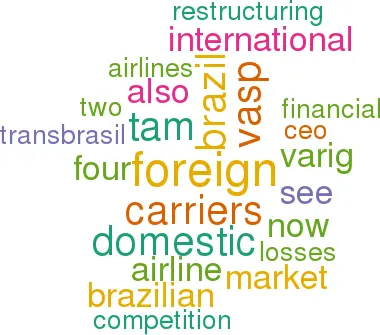Brazil: four become two (or one)?
September 1999


Brazil’s airline industry could be in for a major restructuring if Varig, VASP, Transbrasil and TAM can reach agreement on how to rationalise their international operations in the face of overcapacity and heavy financial losses. The CEOs of the four carriers have been talking about co–operation and even mergers — all seemingly with the full blessing of the Brazilian regulators.
The policy change was confirmed when a high–ranking official from Brazil’s Justice Department said in early August that the government would like to see the four carriers merge into two, suggesting that Varig should pair up with TAM and VASP with Transbrasil. This would be facilitated by a change in competition laws, which currently do not allow an individual company to control more than 50% of the domestic market.
There has been a shift in national priorities. As overseas competition has intensified and foreign companies have taken control over some public utilities, it has become politically desirable to allow mergers that create strong Brazilian–owned companies.
However, the government wants to keep options open for the airlines as there are also plans to raise the limit on foreign ownership of the country’s carriers from the current 20% to 49%.
The airlines have been hit hard by the effects of the January 1999 devaluation and ongoing recession, which have drastically reduced Brazilians’ travel abroad and caused dollar–denominated debt and operating costs to soar. Also, domestic competition has increased sharply due to deregulation over the past 18 months, and price wars have made even key business–oriented routes such as Rio–Sao Paulo unprofitable.
Varig reported a R$49m (US$25m) net loss for the March quarter, which its independent accountants said was understated by R$223m because of the deferral of foreign exchange losses. In April it instigated a new cost- cutting programme, which has involved route and fleet cutbacks and financial restructuring.
VASP, which has aggravated its financial position with foreign airline acquisitions, lost about US$50m in that period and is now trying to renegotiate its US$1.8bn debt. TAM and Transbrasil reported net losses of US$60m and US$16m respectively for the first quarter. So could the world now see the creation of a Brazilian mega–carrier similar in size to a midsize US Major?
As in Canada (see pages 2–3), such a combination controlling practically 100% of the domestic market would probably be frowned on by the regulators.
Consolidation from four to two is also unlikely because of the problem of CEO egos. Although Varig/Transbrasil and VASP/ TAM would make more sense, the latter would be difficult unless TAM acquires VASP. But VASP’s CEO insists that his airline is not for sale (although its foreign subsidiaries Ecuatoriana, LAB and TAN–Argentina apparently are).
It is also a little hard to see how the airlines could combine their international operations while remaining independent and competing in the domestic market, which is believed to be one of the hottest scenarios under discussion. The Mexican CINTRA model, itself causing monopolistic anxieties in that country, is no doubt now being closely scrutinised in Brazil.
Varig would obviously emerge a winner from any restructuring. It is Latin America’s largest airline and has a strong international presence, which the Star alliance will help solidify. It already has a dominant 69% share of Brazilian carriers’ international traffic and a 41% domestic market share.
But consolidation moves in Brazil could complicate established code–share relationships with the US carriers — Varig’s with United, VASP’s with Continental, TAM’s with American and Transbrasil’s with Delta. Those alliances may not be of much help at present, but they showed considerable promise in better times not so long ago. It is worth noting that the Brazilian economy is now on track to resume growth by the end of this year.
More relaxed foreign ownership rules would, of course, attract the attention of the cash–rich US Majors. But Varig’s CEO Fernando Pinto had another suggestion to his US counterparts in a recent speech: Why not use some of that money to promote Brazil as a destination for US tourists? He was referring to the peculiar fact that almost 80% of the USBrazil passengers originate in Brazil.